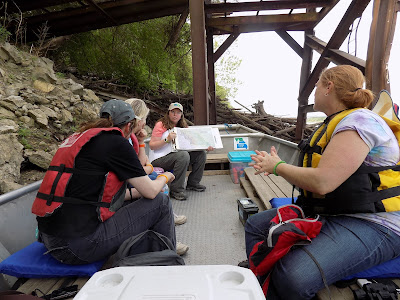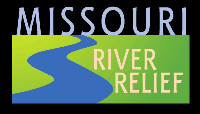By: Claire Hassler, Missouri River Relief
Well, that’s a wrap on our “Stewardship on the Missouri River” education program! Missouri River Relief (MRR) spent the whole day at Katfish Katy’s in Huntsdale, Missouri working with AmeriCorps members from Youth Build and Job Point. The members were young adults, ages 16 to 24, from St. Louis, Kansas City, and Columbia, Missouri. They investigated the river at stations on land and then worked together in service of the Missouri River by picking up trash.
Well, that’s a wrap on our “Stewardship on the Missouri River” education program! Missouri River Relief (MRR) spent the whole day at Katfish Katy’s in Huntsdale, Missouri working with AmeriCorps members from Youth Build and Job Point. The members were young adults, ages 16 to 24, from St. Louis, Kansas City, and Columbia, Missouri. They investigated the river at stations on land and then worked together in service of the Missouri River by picking up trash.
For this education program, we partnered with Job Point, which is an employment center that helps people with career planning and job placement assistance. Job Point was an excellent partner and this program wouldn’t have been possible without them. Thank you Job Point!
We started off the day by introducing the students to the Missouri River, Missouri River Relief, and Job Point. We were also grateful to have Senator Blunt’s Community Liaison Ailey Pope and the Boone County Presiding Commissioner Dan Atwill join the education program and give words of support.
We started off the day by introducing the students to the Missouri River, Missouri River Relief, and Job Point. We were also grateful to have Senator Blunt’s Community Liaison Ailey Pope and the Boone County Presiding Commissioner Dan Atwill join the education program and give words of support.
There were about 60 students at this program. We split them into two groups, 30 in each, because the day was divided into two segments: On the Water and On the Land.
On the Land
For one portion of the day, students rotated through three stations on land to learn more about the longest river in North America. The first On the Land station was called "We All Live Downstream." It was a stream table model of the Missouri River put on by Boone County Storm Water Education.
On the Land
For one portion of the day, students rotated through three stations on land to learn more about the longest river in North America. The first On the Land station was called "We All Live Downstream." It was a stream table model of the Missouri River put on by Boone County Storm Water Education.
Theresa Thomas and Lynne Hooper presented and instructed the students. They taught participants about how stormwater becomes contaminated and also how best management practices improve the quality and reduce the quantity of stormwater that enters the Missouri River.
 |
| Studying the kinds of bugs that live on the Missouri River |
The second land station was called "Through the Eyes of a Scientist" and it was all about using microscopes to investigate macroinvertebrates that live in the Missouri River. Amy Meier and Lily Kennedy with the Missouri Department of Conservation guided the students with the microscopes and showed them all kinds of bugs that live on the Missouri River. They taught participants about adaptations and assessing the quality of a stream site based on the macroinvertebrates that live there.
Station three on the land was a guided bird observation hike hosted by Paige Witek with the Missouri River Bird Observatory. Paige taught the students how to use binoculars and showed them bird skull replicas of species that live along the Missouri River.
Station three on the land was a guided bird observation hike hosted by Paige Witek with the Missouri River Bird Observatory. Paige taught the students how to use binoculars and showed them bird skull replicas of species that live along the Missouri River.
 |
| Giving pointers on how to identify the difference on species of hawks |
On the hike, participants explored the natural history and adaptations of birds that live along the river and got to practice finding the moving birds in their binoculars. After a lunch break, the On the Land group and On the Water group switched places.
On the Water
After a safety talk and getting fitted for life jackets, participants headed out onto the river! MRR had three boats on the water.
 |
| For a lot of AmeriCorps members, it was their first time on the Missouri River. |
 |
| Looking in all the right places for river trash |
 |
| Enjoying the river breeze with beautiful views of the bluffs |
- 21 bags of trash!
- 55 gallon drum
- 2 large Styrofoam chunks
- 2 Large plastic tubs
- Cattle feeding tub
- Large cooler (coffin cooler)
- Plastic tool box
- Large cooler
- 3 tires on rim
- Box tv
- Fridge door
For many students, it was their first time out on the river. Because of this, a lot of growth happened.
At the end of the day as part of our group reflection, we did a whip around activity. The students stood in a giant circle and went around one by one, saying one word they used to describe the Missouri River before today’s program and one word to describe it after today’s program.
Here are some things the students said:
Here are some things the students said:
- Before / After:
- Big / beautiful
- Trashy / cool
- Watery / peaceful
- Dirty / relaxing
- Gross / refreshing
- Dirty / fun
- Scary / chill
- Dirty / serene
- Big / tranquil
The day was hot, but our students and presenters were champions and finished the day with smiles on their faces and chilled towels on their heads!
A lot of people helped make this program happen. A big thank you to our experienced boat drivers and deckhands: Steve Schnarr, Kevin Tosie, Jeff Boot Barrow, Patty Farrar, Steve Sadich, and Mike Crist. And our amazing presenters included Amy Meier, and Lily Kennedy with the Missouri Department of Conservation, Theresa Thomas and Lynne Hooper from Boone County Stormwater and Paige Witek from the Missouri RiverBird Observatory.
If you would like to learn more about MRR education programs, please contact Education Director Kristen Schulte at kristen@riverrelief.org, and check out our education program page!
























